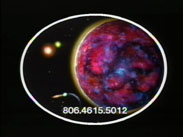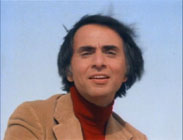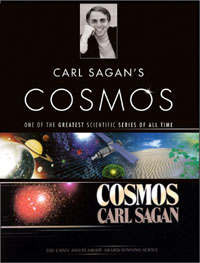|
This episode opens with a dramatization of a famous UFO case involving
Betty and Barney Hill. (I have to keep resisting the temptation to call them
the Rubbles, in honour of the Flintstone cartoon characters.) Sagan recounts
a lot of what supposedly happened, then drives hard to emphasize the unreliability
of all of the information.
His key testimony concerns a map of nearby stars, which becomes a fascinating
example of how arbitrary interpretation can lead people to fairly meaningless conclusions.
What he doesn't seem to realize is how well this works both ways.
Sure, those who attempt to use this to prove the accuracy of the Hills' story
are reaching, and it doesn't hold water. But, I think, those like Sagan who attempt to
conclude from this that the Hill's story must be bunk are also reaching. Exactly
how well would you expect a groggy person to remember a map of pinpoints several
weeks after the fact without taking any notes? The inability to remember a map
with a high degree of scientific accuracy doesn't prove that Betty Hill didn't
have an experience on an extra-terrestrial craft.
For that matter, one also has to wonder why scientists insist that science
has to rule the question of our meetings with aliens. If someone says that
they met a new neighbour from down the street one night, we don't typically
doubt them until scientific proof can be brought to bear. Why is science so much
more necessary for stories of alien encounters? I like to flip Sagan's usual
questions around 180 degrees and ask if there is any solid scientific reason to
doubt a story such as Betty Hill's, and practically speaking, the fact that the
map isn't any more accurate than I would expect considering the path the information
took going through Hill's story, it hasn't given me any more reason to doubt the story.
In fact, this begins to point towards a few false expectations in general
from the scientific community in terms of how well any of us might believe
that factors of states of mind and emotion can be isolated, and thus discounted
as having any effect on the results of either controlled experiments or careful
scientific observations. Typically, if a scientist isn't specifically testing
for those things as their primary interest, he or she tends to be uninterested
even in considering such things as contributing factors of perhaps secondary
interest - at least traditionally, in Sagan's time. There does however seem
to be a bit of a revolution in quantum physics, for those scientists who feel
they have little choice but to look at such things in order to move their
understanding forward.
Perhaps ideas of states of mind are much more naturally suited to the
concept of "meeting one's neighbours" in space, which probably should be
more about social graces and politics than science. Indeed, one of the
common recurring themes of UFO reports and contact literature is the idea
that intelligence evolved elsewhere doesn't necessarily inhabit the same
range of brain wave rhythms and frequencies
as do most animal minds on our own planet.
We humans spend most of our waking, intellectual, scientifically pondering
moments operating at something called the beta-wave frequencies,
where our dominant brain waves fluctuate between 14-21 Hertz.
(1 Hertz = 1 cycle per second.)
Many scientific studies have shown that increased psychic awareness,
creativity, and dreamworld processing occur in other ranges of
brain-wave frequencies, such as the alpha (7-14 Hz), theta (4-7 Hz),
and delta (0.5-4 Hz) ranges.
Armed with this consideration, it would be presumptuous of us
to assume that extra-terrestrial beings would also evolve to function
in this exact same range for their primary day-to-day physical/social activities,
or more specifically, that they would be as limited to beta-wave brain
frequencies as we are. According to much of the contact literature,
they can combine beta, alpha, and theta operations much more efficiently
than we can - and in fact this has a side effect on us when we encounter them.
If we listen to what they're communicating to us on the alpha or theta
ranges, our beta range shuts down - we nearly fall asleep, and we feel like we're
dreaming the whole thing.... and this is all about us following our own habits
of keeping these aspects of our own minds compartmentalized.
Ever try to show a book to a cat? Most of the cats I have known refuse
to even look directly at a book. Put it in front of their face, and they turn away.
It's as if it's too complex a concept for them. And yet we know cats are smart.
It shouldn't be beyond them to appreciate a photo in a book. Yet most of them
won't even look at one, and refuse to buy into its existence. Are we humans
doing the same with our encounters with extra-terrestrials, while also
believing we are oh-so-smart?
But I digress...
Champollion
A fairly significant chunk of this episode is devoted to the story of
Champollion deciphering Egyptian hieroglyphics and marveling at their culture
and architecture. I like this section, as it is an interesting piece of
history to learn, it celebrates the diversity of culture within our own
species, and it appeals to my code-breaking instincts as well.
But at the same time, I don't feel it is quite as relevant to the
central extra-terrestrial theme as Sagan thinks it is. It seems to me that
the previous episode's segments of dolphins and whale songs were actually
more poignant and relevant. At least there, communication between different
intelligent species could be examined, even if both are from the same planet.
With Egyptian hieroglyphs, it's the same species AND the same planet - less
close to the big challenge that we're warming up for.
Radio-Astronomy
At the episode's midpoint, Sagan makes his greatest pitch for E.T. contact,
focusing on radio-telescopes. Part of the build-up here includes his criterion
that the method of communication should be FAST - to cover interstellar distances
quickly. If it's true that the speed of light is constant between all stars in
interstellar space, then I would conclude that radio signals are FAR TOO SLOW
to be considered practical. The human species has yet to possess radio technology
for the length of time it would take for a signal to reach most stars, let alone
go out and come back. The really BIG question concerning this is: How long
would any species remain excited about using a technology with these limitations,
not before they blow themselves up, but before they discover a much better technology
that works much faster?
In fact, if we really work with alpha and theta brain frequencies, we may discover
that there's a great psychic internet already in existence between all specie,
regardless of their interstellar locations.
Telepathy may already be the great connector of truly intelligent, advanced specie
all across the galaxy, and the human race has yet to develop its own faculties
in this regard. What little telepathy we know how to use isn't considered all
that reliable for us yet - likely because it's more associated with interpretation
and the world of our dreams rather than the beta-dominated frequency range of
practical daily usage and scientific endeavours. If we knew how to integrate
the various aspects of our minds, perhaps it would appear more reliable,
feasible, and attractive. As far as the speed factor goes, it's got radioastronomy
beat by a longshot.
At any rate, Sagan's push for radioastronomy to be THE primary method
for initiating extra-terrestrial contact feels to me like a primitive tribesman
getting excited about lacing North America up with empty tin cans connected
by strings. Okay, the string-can phone might seem exciting if you never had
anything else previously, but the continent went for fibre-optics some time ago.
Move with the times...
Also quite noticeable is how Sagan's ideal E.T. contact scenario laid
out here is pretty much a perfect blueprint for what happens in the Jodie Foster film
"Contact", which was made from Sagan's novel. I'd put money down that
(a) the first E.T. contact has already happened, and
(b) the first publicly acknowledged E.T. contact, even if it is a future event,
will play out rather differently.
The Drake Equation
The Drake Equation is an interesting concept, and Sagan spends a good chunk
of time explaining the details of it and using it to make some calculations.
What is interesting is how the equation becomes the eye of the needle for the
entire Cosmos series. Most of the topics covered in previous episodes turn out
to be pre-requisites for understanding this one equation, topics which now thread themselves
through this one simple segment in a radio-telescope control room. One more topic
is new here, and the Drake equation kind of sets it up and gives it an unforgettably different
sense of importance before Sagan goes on to tackle it for his final Cosmos episode.
Finally, we get another sequence of imagination, from which the episode
takes its title. Sagan gets to browse through an
Encyclopaedia Galactica, provided by some imagined space-faring E.T. race,
examining planet after planet to see what the conditions and life-forms there
might be like. This is one of the cooler sequences on Cosmos as a whole,
and remains one of my favourites as well.
Finally, we get the "Cosmos Update". This is almost funny, as Sagan appears genuinely
amazed and frustrated that people haven't yet dismissed all those pesky UFO reports
to embrace his viewpoint instead. Sorry, life doesn't work like that!
Overall, this is not too bad an episode, and it contains a lot of excellent
and enjoyable sections. When Sagan's dismissive bits are taken with their
fair share of grains of salt, it remains a palatable and worthwhile episode
to watch multiple times.
|










